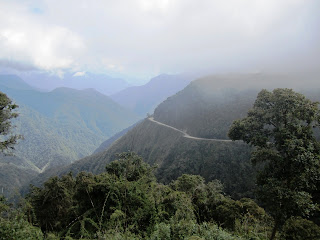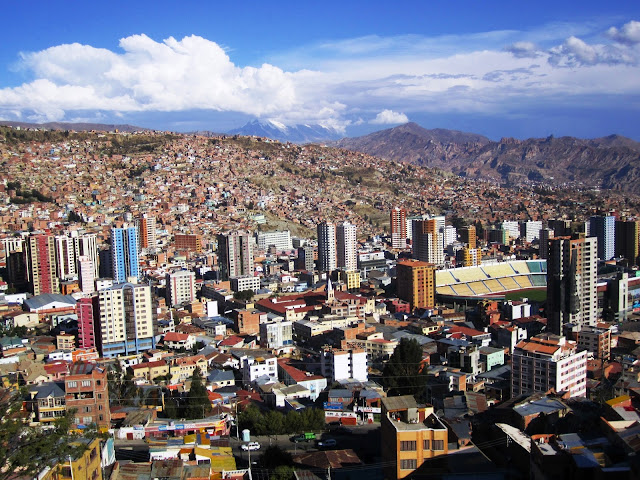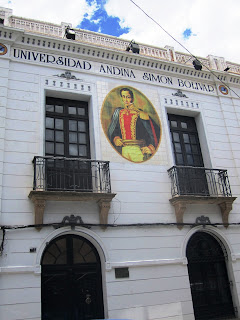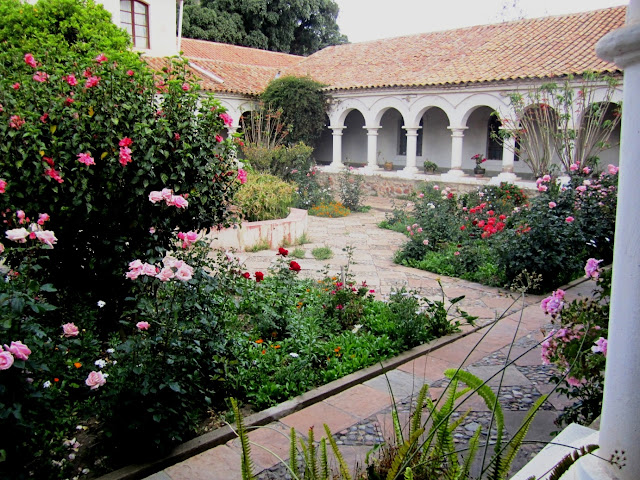 My itinerary said nothing
about risking my life!
My itinerary said nothing
about risking my life! It simply said: ‘In less than 3 hours’ drive, and after an amazing trip full of gorgeous sights, the Yungas Valley is reached, where the most exotic and delicious fruits are grown.’
In fact, from the 8am pick-up to the 12.45pm drop-off at the hotel in Coroico for lunch, was a 4¾ hour drive, with a few short stops here and there, and I never did see any exotic and delicious fruits. But what a drive!
First, we wound up through
housing perched precariously on the clay cliffs above the city, then on to a road
between high hills that looked like they’d been carved by glaciers eons ago. We
passed a dam whose reservoir supplies most of La Paz’s water, though its level
is currently low, awaiting the onset of the rainy season to replenish it. We
passed an area of small shops selling mattresses stuffed with the tufty
mountain grass that grows so plentifully at these altitudes. And we passed vans
stuffed full of mad young people about to risk their lives on the mountain
bikes propped atop the vans by biking Bolivia’s infamous Death Road.
The highest point on our
journey was soon reached – 4700 metres above sea level. It is marked by a
statue of Christ, around which were scattered empty alcohol bottles and the remains
of fires. If the guide hadn’t told me these were offerings to Pachamama, I
would have thought it was the remnants of some drunken party! We passed two
small towns, Pongo and Unduavi; the second was a breakfast stop for our driver
while I wandered up and down taking photos. Up to the right you could see the
reverse side of Mururata, the flat-topped snow-covered mountain that towers
above La Paz.
 |
| Mountain bikers prepping for their ride |
 |
| The road to Coroico |
 |
| Mt Mururata |
About 50kms from the city, we turned off the wide, new, tarsealed road on to a dirt and gravel road, the old road to Coroico, the aptly named Death Road! It was narrow, hair-raising and bumpy; at times stomach-churning for someone who doesn’t particularly like heights because the drop to one side was often vertical for a thousand feet or more; sometimes wet and greasy from waterfalls cascading directly on to the road from the towering cliffs above; often scary negotiating unstable narrow tracks across huge rockslides that had wiped out whole mountain sides.
My heart was in my mouth
for almost the entire 20kms we stayed on the road, except for the couple of
times I walked a short way so my guide could take photos of me standing above
sheer drops. I was so much more comfortable with my feet on the ground and I
would, in fact, have been very happy to have walked the road, as it was all
down hill and the views were spectacular. One particularly wet part had been
nick-named St John Baptiste, as the mischievous truck drivers who used to carry
people up this road would pause there a minute or two, thoroughly wetting their
passengers.
 |
| Me checking out the sheer drop - but not too close! |
 |
| The size of the truck gives a good indication of the size of the cliffs |
We saw plenty of evidence
of why the road got its name – the roadside crosses are numerous! Now, the road
is mostly only used by tourists and mad mountain bikers, and over-jealous
bikers are the only ones who die on the road. We were passed by many adrenalin
junkies, and saw one injured, luckily not badly as he’d skidded to the right
side of the road, not over the edge!
We eventually emerged into
the Yungas Valley, where much coca is cultivated in small plantations at the
side of the road. There is supposedly a lot of wildlife in the area, though I
saw only a few butterflies and, later, on the road back, some large birds of
prey – Caracaras and Andean vultures – no monkeys or parrots.
 |
| Some pretty butterflies |
 |
| A coca plantation |
Coroico is a small town of
around 10,000 people, clinging to the steep hillsides amidst lush vegetation.
Its climate is semi-tropical and it was hot, about 30°C. It exists as a
retirement place for the rich of La Paz and as a weekend vacation spot. I was
surprised to see a few black people there, especially one older woman who looked
somewhat incongruous dressed in traditional Bolivian costume, complete with
small bowler hat perched on her frizzy hair. These blacks are the remnants of
the African slaves who were brought to Bolivia by the Spanish in the 16th and
17th centuries to work the silver mines at Potosi.
 |
| In the distance, Coroico |
Lunch was delicious, at a
posh but empty hotel: palm hearts with tomato and lettuce salad; peanut noodle
soup – a local favourite; some kind of breaded meat with chipped potatoes and
coleslaw; and rich and refreshingly cold chocolate ice cream! No wonder Tony
kept knodding off during the two-hour drive back to La Paz – I could’ve done
with a siesta as well, but didn’t want to miss a moment.
The drive back was on the ‘new’
road – it was actually begun in 1935 by prisoners of war. They were from the
last war fought by Bolivia: the bloody Chaco War with Paraguay from 1932-1935
over a disputed piece of territory. The road is an impressive piece of engineering,
needing constant repair, as it winds up and over the mountains. Some sections
are cantilevered out over deep precipices, and there are several tunnels, one
of which is perhaps a kilometre long, directly through a mountain top.
As we neared La Paz, the
weather began to close in behind us, with mist and low cloud swirling eerily around.
I was so glad we had enjoyed fine clear weather earlier in the day and, though
I was exhausted from the nervous tension of the journey, I was also happy to
have seen such stunning landscapes, and to have travelled such a treacherous
road and survived!

















































